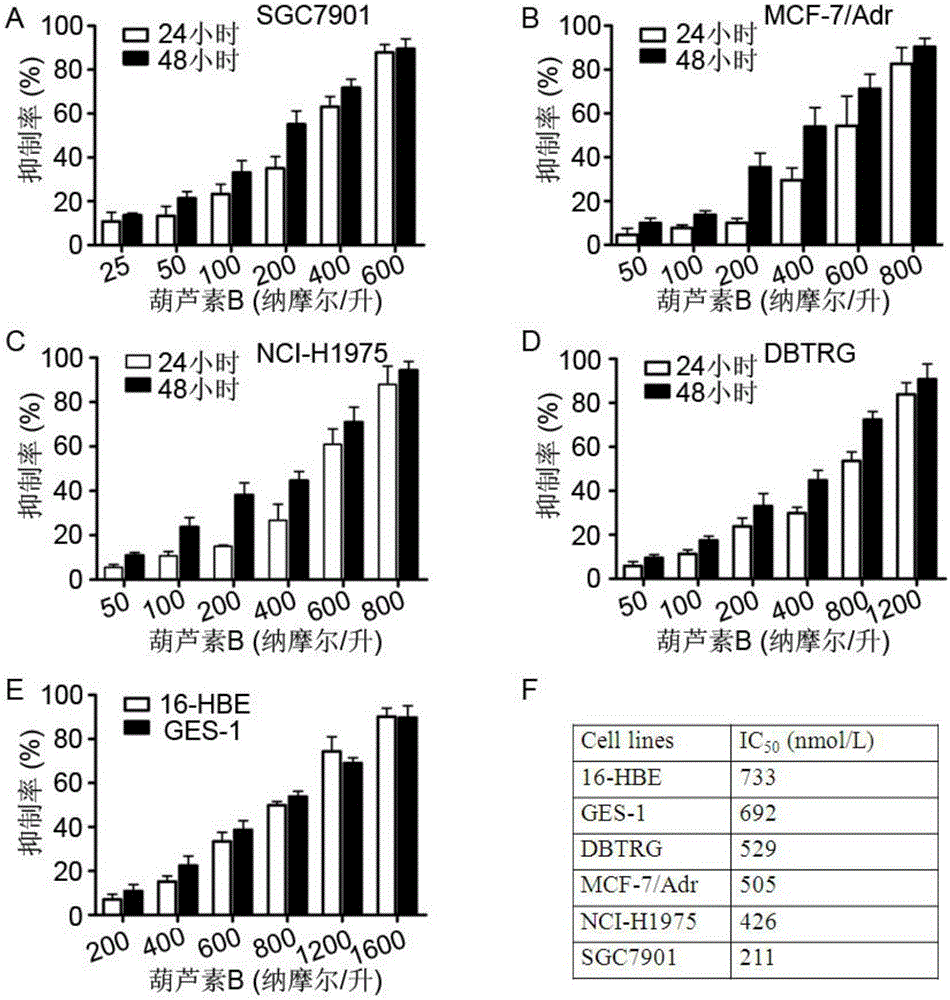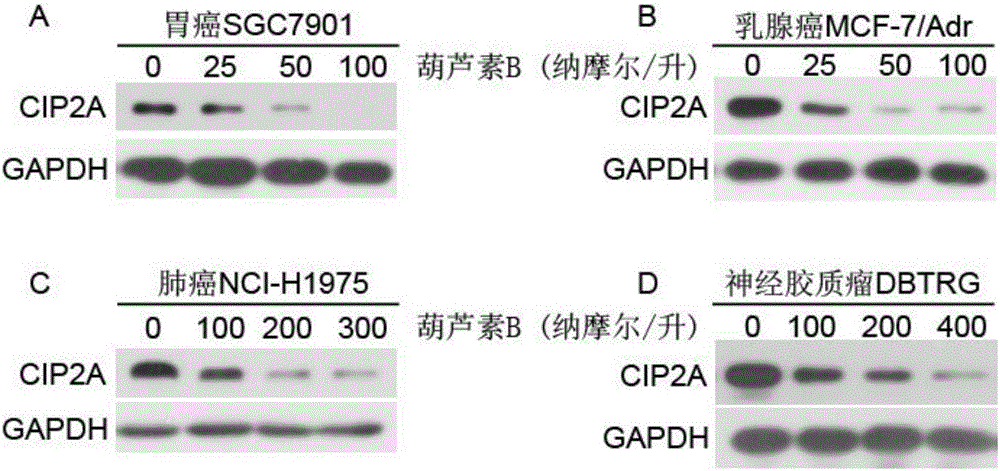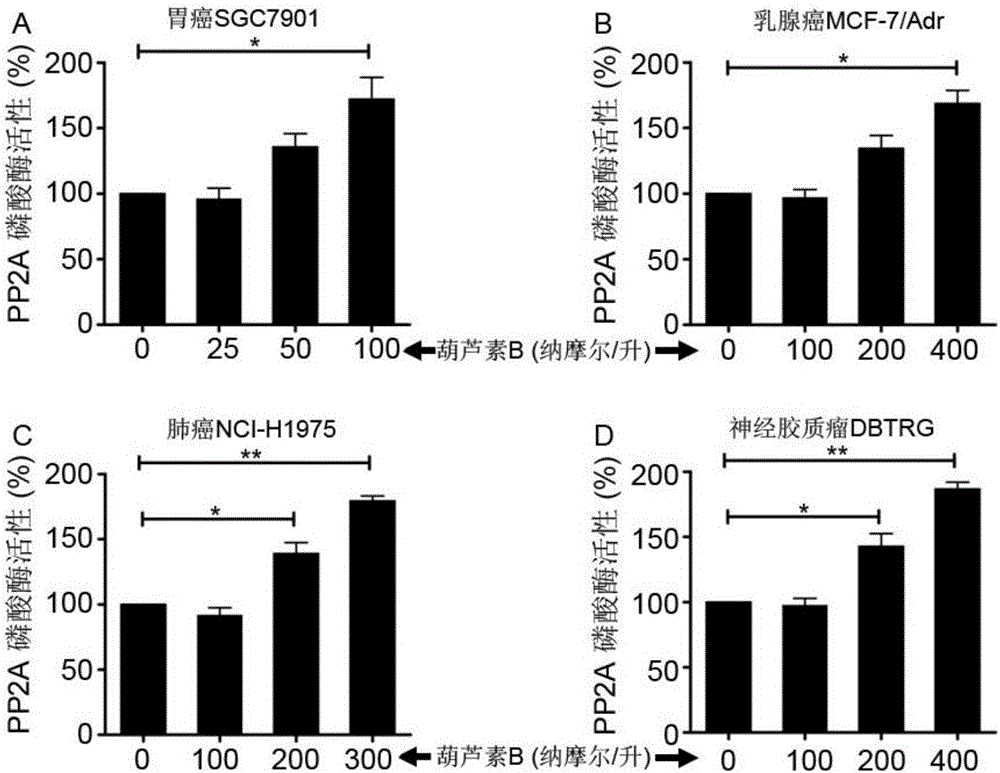Application of cucurbitacine B to preparation of cancerous inhibitor of protein phosphatase 2A
A protein phosphatase and inhibitor technology, applied in the field of medicine, can solve the problems of insensitivity of anti-growth signals, tumor cell escape and apoptosis, etc., and achieve the effect of significant curative effect, clear target and broad anti-cancer application prospects.
- Summary
- Abstract
- Description
- Claims
- Application Information
AI Technical Summary
Problems solved by technology
Method used
Image
Examples
Embodiment 1
[0016] Example 1 Cucurbitacin B inhibits the growth of gastric cancer, breast cancer, lung cancer and glioma cells
[0017] The various types of cancer cell lines SGC7901 (gastric cancer), MCF-7 / Adr (breast cancer), NCI-H1975 (lung cancer), and DBTRG (glioma) cells in the logarithmic growth phase and human normal bronchial Epithelial cells 16-HBE, human normal gastric mucosal epithelial cells GES-1 were seeded in 96-well plates (approximately 5000 cells per well, 90μl medium), and cultured (37℃, 5% CO 2 Incubator) 24 hours later, 5 kinds of cells were treated with Cucurbitacin B (CuB) with different concentration gradient (10-1200nmol / L). After culturing for 20 and 44 hours respectively, add 10μl of 3-(4,5-dimethylthiazole-2)-2,5-diphenyltetrazolium bromide (MTT) solution at a concentration of 5mg / ml to each well, continue Cultivate for 4 hours. After terminating the reaction, aspirate the medium, add 150 μl dimethyl sulfoxide to each well, shake at low speed to fully dissolve, ...
Embodiment 2
[0018] Example 2 Cucurbitacin B inhibits the expression of CIP2A protein in gastric cancer, breast cancer, lung cancer and glioma cells.
[0019] The specific implementation method is as follows:
[0020] Inoculate various types of cancer cell lines SGC7901 (gastric cancer), MCF-7 / Adr (breast cancer), NCI-H1975 (lung cancer) and DBTRG (glioma) cells in a 6-well plate at a certain density. Hours later, when the cell confluence reached 80%, SGC7901 cells (0nmol / L, 25nmol / L, 50nmol / L, 100nmol / L) were treated with different concentrations of CuB, MCF-7 / Adr (0nmol / L, 100nmol / L) L, 200nmol / L, 400nmol / L), NCI-H1975 cells (0nmol / L, 100nmol / L, 200nmol / L, 300nmol / L), DBTRG cells (0nmol / L, 100nmol / L, 200nmol / L, 400nmol / L) After 24 hours, the cells were lysed with 1×SDS Loading Buffer to extract total protein, and Western Blot immunoblotting experiment was performed with the same amount of protein, using anti-CIP2A and anti-GAPDH (glyceraldehyde-3-phosphate dehydrogenase) antibodies respecti...
Embodiment 3
[0021] Example 3 Cucurbitacin B inhibits the phosphatase activity of CIP2A substrate protein PP2A in gastric cancer, breast cancer, lung cancer, and glioma cells
[0022] The specific implementation method is as follows:
[0023] Inoculate various types of cancer cell lines SGC7901 (gastric cancer), MCF-7 / Adr (breast cancer), NCI-H1975 (lung cancer) and DBTRG (glioma) cells at a certain density in a 10 cm culture dish, 24 After hours, when the cell confluence reached about 70%-80%, SGC7901 cells (0nmol / L, 25nmol / L, 50nmol / L, 100nmol / L) were treated with different concentrations of CuB, MCF-7 / Adr (0nmol / L) , 100nmol / L, 200nmol / L, 400nmol / L), NCI-H1975 cells (0nmol / L, 100nmol / L, 200nmol / L, 300nmol / L), DBTRG cells (0nmol / L, 100nmol / L, 200nmol / L) , 400nmol / L), 24 hours later, use RIPA lysis solution to lyse four kinds of cells treated with different concentrations of CuB, and store the protein solution at -20°C. Take 100μg of each protein and incubate with 4μg of PP2A antibody respec...
PUM
 Login to View More
Login to View More Abstract
Description
Claims
Application Information
 Login to View More
Login to View More - R&D
- Intellectual Property
- Life Sciences
- Materials
- Tech Scout
- Unparalleled Data Quality
- Higher Quality Content
- 60% Fewer Hallucinations
Browse by: Latest US Patents, China's latest patents, Technical Efficacy Thesaurus, Application Domain, Technology Topic, Popular Technical Reports.
© 2025 PatSnap. All rights reserved.Legal|Privacy policy|Modern Slavery Act Transparency Statement|Sitemap|About US| Contact US: help@patsnap.com



